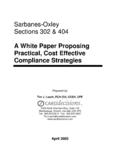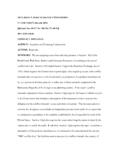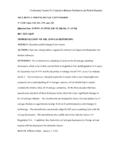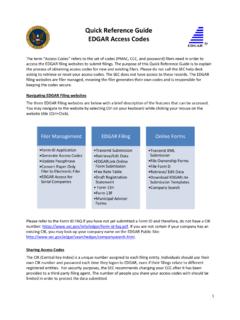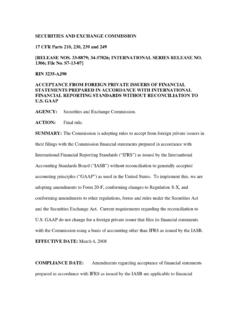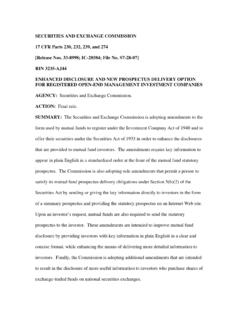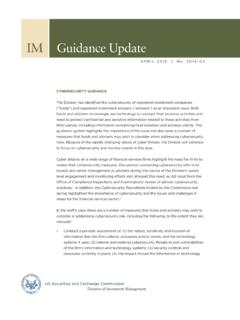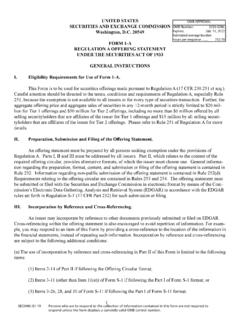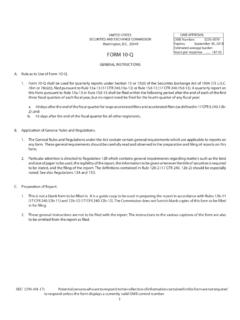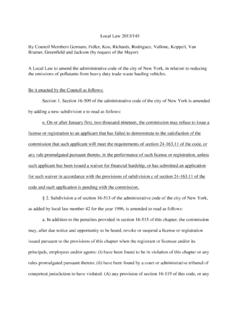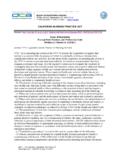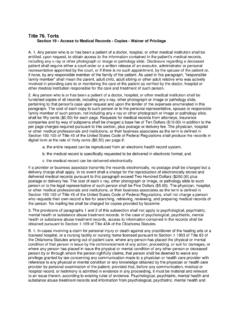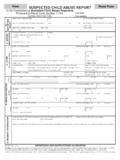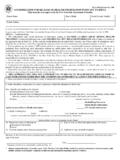Transcription of Report Pursuant to Section 704 of the Sarbanes-Oxley Act ...
1 Report Pursuant to Section 704 of the Sarbanes-Oxley Act of 2002 Table of Contents I. Executive Summary II. The Statutory Language III. Objectives, Scope and Methodology IV. Results of the Study - Areas of Reporting Most Susceptible to Fraud A. Improper Revenue Recognition 1. Overview of Findings 2. Discussion of Representative Cases and Description of Issues a. Improper Timing of Revenue Recognition i. Holding Books Open After Close of a Reporting Period ii. Bill-and-Hold, Consignment Sales, and Other Contingency Sales iii. Multiple Element Contracts or Bundled Contracts b.
2 Fictitious Revenue c. Improper Valuation of Revenue 3. Analysis and Conclusions B. Improper Expense Recognition 1. Overview of Findings 2. Discussion of Representative Cases and Description of Issues a. Improper Capitalization/Deferral - Failure to Record Expenses or Losses b. Overstating Ending Inventory Values c. Improper Use of Restructuring and Other Liability Reserves d. Understating Reserves for Bad Debts and Loan Losses e. Failure to Record Asset Impairments 3. Analysis and Conclusions C. Improper Accounting in Connection with Business Combinations 1.
3 Overview of Findings 2. Discussion of Representative Cases and Description of Issues a. Improper Asset Valuation b. Improper Use of Merger Reserves c. Inappropriate Application of Purchase/Pooling Methods 3. Analysis and Conclusions D. Other Areas of Improper Accounting 1. Overview of Findings 2. Discussion of Representative Cases and Description of Issues a. Inadequate Disclosures in Management Discussion and Analysis ( MD&A ) and Elsewhere in Issuer Filings b.
4 Failure to Disclose Related Party Transactions c. Inappropriate Accounting for Non-monetary and Roundtrip Transactions d. Improper Accounting for Foreign Payments in Violation of the FCPA e. Improper Use of Non-GAAP Financial Measures f. Improper Use of Off-Balance Sheet Arrangements 3. Analysis and Conclusions V. Results of the Study - Persons Involved in Financial Reporting Violations A. Overview of Findings B. The Individuals Charged 1. Senior Management 2. Mid-Level Management 3.
5 Counsel 4. Customers VI. Results of the Study - The Role of the Auditors A. Overview of Findings B. The Charges in Cases against Auditors C. The Audit Failures D. Size of Audit Firms Where Audit Failures Occurred E. Discussion of Representative Cases F. Analysis and Conclusions G. Provisions of Sarbanes-Oxley Act Applying to Auditors VII. Proposals Based on the Study A. Pre- Sarbanes-Oxley Enforcement Tools B. Provisions of Sarbanes-Oxley Act 2 3 C. Proposals 1.
6 Uniform Reporting of Restatements 2. Issuing an Interpretive Release, or Adopting Revisions to Commission Rules, on Management s Discussion and Analysis of Financial Condition and Results of Operations 3. Production of Internal Reports Without Waiver of Privilege 4. Access to Grand Jury Materials 5. Nationwide Service of Process for Testimony in Commission Litigation VIII. Conclusion Exhibit A - Listing of Actions Filed Report Pursuant to Section 704 of the Sarbanes-Oxley Act of 2002 I. Executive Summary1 The past year has been marked by a series of restatements of financial statements by prominent corporations resulting in billions of dollars lost by investors.
7 To address concerns raised by these restatements, and to restore public trust in the financial markets, Congress passed the Sarbanes-Oxley Act of 2002 ( the Sarbanes-Oxley Act ), which the President signed into law on July 30, The Sarbanes-Oxley Act, among other things, creates an independent accounting oversight board; provides more enforcement tools to the Securities and Exchange Commission ( Commission ); restricts non-audit services by accounting firms; holds corporate executives accountable for the accuracy of financial reports; increases criminal penalties for securities fraud; and provides for the separation of investment banking and investment analysis.
8 Section 704 of the Sarbanes-Oxley Act directs the Commission to study enforcement actions over the five years preceding its enactment in order to identify areas of issuer financial reporting that are most susceptible to fraud, inappropriate manipulation, or inappropriate earnings management (the Study ). In addition, Section 704 directs the Commission to Report its findings to Congress, including a discussion of recommended regulation or legislation (the Report ). This Study involved the review of all of the Commission s enforcement actions filed during the period July 31, 1997 though July 30, 2002 (the Study period ) that were based on improper issuer financial reporting, fraud, audit failure, or auditor independence violations.
9 Over the Study period, the Commission filed 515 enforcement actions for financial reporting and disclosure violations arising out of 227 Division of Enforcement investigations3 (these investigations are referred to hereafter as enforcement matters ).4 See Exhibit A for a listing of actions filed during this period. The 515 actions included 869 named parties, consisting of 164 entities and 705 During the Study period, the number of enforcement actions involving issuer financial reporting violations or fraud increased from 91 in the first year of the 1 References to accounting standards are for informational purposes only, and should not be construed as recitations of generally accepted accounting principles ( GAAP ) or interpretations by the Commission.
10 2 Corporate and Auditing and Accountability, Responsibility, and Transparency Act of 2002, No. 107-204. 3 Some of the actions brought during the Study period involved conduct that occurred before the Study period. 4 During the same time period, the Commission filed a total of 2508 enforcement actions, arising out of 1390 investigations. 5 More than one action may result from a particular investigation. Although most of the enforcement matters related to one issuer, there were matters involving multiple issuers. Study to 149 in the last year of the Of these 515 actions, 186 were federal civil actions and 329 were administrative Of the 869 named parties, the Commission charged 593 with fraud in connection with the reporting violations: 511 individuals, and 82 entities.
